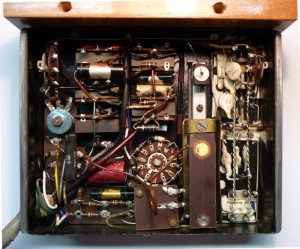As this is a techie blog, I’ll start with some impressions of the electronics as I found them when I disassembled the Ondes Martenot.
I assume some knowledge about the function of this instrument. If you’re new to the Ondes Martenot, you’d probably like to have a look at Thomas Blochs website and Wikipedia
This is the main electronics unit from below.
Almost all film capacitors (most of them of the paper type, sealed with tar in a glass tube) and resistors need to be replaced either of degradation in value, short or open circuit.
On the left side, within two separately shielded boxes, are the two LC oscillators, each featuring an EF94 (6AU6) pentode tube. As you may already now, the Ondes Martenot is based on beat-frequency oscillators, like the Thermin or the Spärophon. The fixed (more or less at least – it is tunable to achive tuning of the instrument) oscillator is told to oscillate at 200kHz – I still have to verify this, but for now, let’s assume it is correct. An additional transpose switch also works on the fixed oscillator.
The second one is set up to be variable between 180 and 200kHz by means of either a keyboard or the ribbon controller with the finger ring typical to the Ondes Martenot. While the ribbon controller works on a gigantic variable capacitor (the conductive ribbon passes an array of capacitor plates, photos will follow), the keyboard switches a string of inductors. This gives the higher note priority known from many other monophonic synthesizers. In addition to the keyboard or ribbon control, two push buttons with switchable capacitors and 3 metal knobs also connected to the LC tank circuit via low value capacitors allow for further influence on the tone. Switch No. 7 adds some lose coupling from the variable oscillator output to the grid circuit, its function will be further analyzed when the mixer circuit is operational as it also changes the mixer configuration.
The third EF94 tube is used as a mixer, bringing back the outputs of the two oscillators into the audible range between 0 and 20kHz. The mixer is followed by the fourth EF94 as a pre-amplifier. Its screen grid is connected to some circuitry in the drawer (see below) to allow for various sound modification.
Final amplification is accomplisged by an EL84 output pentode. Volume control, which is major important for the Ondes Martenot because of its free wheeling oscillators, is achieved with the “touche d’expression”, a large button on the drawer with compresses a little bag with conductive powder. Working like a carbon powder microphone, it emulates a potentiometer in the EL84’s cathode circuit. The output transformer is somewhat special because of its three secondary windings for three different speakers which could be operated simultaneously on the Ondes Martenot. Two filter functions are realized within the output amplifier: Switch No. 0 allows to connect a choke in series with the output transfomer’s primary winding, and a capacitor in series with a potentiometer connected in parallel with the primary allows for tone control. This potentiometer is also of the carbon bag type, operated by a knee pedal.
This photo shows the inside of the drawer. This small panel contains almost all important controls of the Ondes Martenot.
On the right side you can see the switch toggling between keyboard and ribbon control (upper right corner) and the push buttons and metal knobs influencing the variable oscillator mentioned above.
The big rotary switch in the lower center allows for logarithmic control of the output level for the main speaker (D1, “diffuseur principal”) to match its volume with other speakers. Nine toggle switches allow for various sound modifications, while the switch in the upper left corner connects a bridge rectifier (the blue disky thing on the left) in series with the output.
One can assume that all those modifiers enable interesting effects on the originally generated sine wave. The next step towards the synthesizer would probably be a sawtooth oscillator like the Trautonium used.


